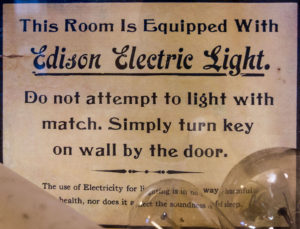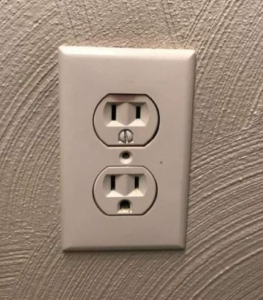I have long suspected that Technology has gone (and continues to go) beyond what people can handle, that “consumer electronics” is over (perhaps well over) the head of the typical consumer. There’s a lot to this observation / suspicion, and I’ll only cover a little here.

How Things Work not being obvious isn’t exactly a new problem, as this circa 1920 sign illustrates. (Admittedly, not unreasonable.) By the way, both of the “not unhealthy” statements at the bottom of the sign have been disproven time and time again over the century since this sign was current.
Consider: In & around 1970 there were about 100,000 computer programmers in the world. Today there are 10’s of millions of folks who are called programmers, most of them work on Websites or at most some of the business automation layers, or on stringing together small, mostly redundant products of limited value, and which only rarely involve any “real” programming. There are all kinds of programmers, though, of course, just like in any trade. But note: the upper-most tier of programmers, the ones who could create a significant new web browser, build a new Operating System, fix Windows, make an electronic voting system that is actually honest and secure, or do new research into brand new things, etc, number about… 100,000. Still. Most “programmers” today haven’t a clue why what they do does what it does; they just know how to string black boxes together… most of the time.
Consider: The banking automation layer is increasingly buggy, per my own personal observations among several banks. The times one has to get on the phone or go inside to the bank to deal with a “computer issue” are increasing. Also, the people inside the bank rarely know how to fix said problem, which usually means the branch manager has to get on the phone to HQ and their in-house tech support to figure out how to fix it. Per my observations, bank employees don’t know basic banking any more; they know how to operate the bank’s teller software… most of the time, but take away the computer and they can’t help you.. When the computer goes down, the branch is out of business until it comes back up. That is just not an acceptable way to conduct business. The “primitive 60’s and 70’s” provided better banking service.
Consider: How often do you have to take your car to the shop because the idiotic for-idiots-only “check engine” light is on, but fails to say why? The tech plugs in his computer (if he has one — increasing numbers of “auto techs” don’t have the computer or know how to use one) and it reports that the gas cap is lose, or some similar near-nothing. This is a total failure in design. Why can’t the car simply report, on its dangerously distracting video display, at the very least a nice clear “please check the gas cap” message instead? Half a dozen computers in a car and the best you can do is a light on the dashboard?
Consider: Consider Microsoft’s newest fad in error messages: “something went wrong.” Maybe followed by “try again later” or (even less helpful) “we’ll try again later.” That is supposed to be helpful? Informative? Reassuring? That is total BS, and does nothing for me but further lower my trust in Microsoft (and Apple — they’re starting to do that same BS kind of error messages, unfortunately).
Consider: Or, the other style of error message from Microsoft that says something like “blah-blah failure, code 0x08000xxxxx.” That’s no better, especially, as it turns out, that the codes Windows gives you have only the most general meaning in themselves if you can even track down the code. Any one code seems to have several different possible causes — which is the worst kind of software design — and I can give expert testimony to that one, m’self, I can, I can. Further, there appears to be no go-to manual from Microsoft defining these error codes. There is much chatter on the internet among people trying to explain these codes to each other, based mostly on “this worked for me.” That’s also an unacceptable way to conduct business.
Consider: Back to cars, did you know (or maybe you even remember?) that back in the late 1970’s / early 80’s cars were pushing 50 even 55 miles to the gallon? (A few of them.) That was before computers, before any one even had an idea why one might want a computer in a car. Now we have several processors in a car, all making 1,000’s of adjustments per second for maximum efficiency… to achieve all of 25+ miles to a gallon, if you are lucky. Something very, very wrong with that one!
Consider: In America, probably other countries as well, people never did figure out (for the most part) how to set the time on their VCRs. It was too complicated, even with the instructions right in front of them(1). Nor could most people hook together a component stereo system. Lots of people made a (brief) living by just installing stereos in people’s homes. That so many people should have no feeling what so ever for what is, after all, a really simple (especially by today’s standards) bit of “consumer electronics” is something that might give an extraterrestrial observer, watching Humans in their native habitat, the Heebie Jeebies. And it’s not that people are stupid, they’re not. It’s the design of the equipment and the documentation. It’s not, and never has been, consumer friendly.
Consider: Finally, because, as I said, there’s an awful lot to this subject (the subject of technology, now being mass marketed instead of handled only by specialists, is sorely beyond the understanding of the typical consumer), consider the following picture, gleaned off of Facebook. (The picture is apparently genuine, not staged, but one has to consider it might be staged. On the other hand, it doesn’t really matter, as you know this scenario exists in many places.)

An example of why DIY sometimes is not a good idea. Or is it a face with a mask on, above a face without?
There are ways to fix this, of course. The screw hole and the grounding connection should not have the same shape, for one thing. (Though you might still end up in a “round peg in a square hole” scenario, which *is* an intelligence test, by the way.) Also, an outlet should have an automatic cover that slips into place when no plug is inserted (and further engineer the cover to automatically slip out of the way when plugging in a cord — that’s easy to do, really; it would also take care of child safety issues where children aren’t educated sufficiently to not play with such things), the outlet should also be dead when there’s no cord plugged in, and so on. Many things wrong with the modern American power outlet. So, yeah, there’s some really bad engineering here; all the same, this picture is a serious statement. The hypothetical person who installed this outlet plate understands not at all the function of the hole used, nor the function of the screw, nor the relationship between the outlet and the cover plate, nor…
I have clients that I know would not be able to see the problem in that photo till it was pointed out. (No judgments here, no right or wrong; as I said, there’s really some pretty crummy and indifferent engineering to these potentially very dangerous power outlets, so actually we’re all to blame on this issue!) Of course, most of my clients wouldn’t even attempt to change an outlet plate in the first place. More’s the pity. Sometimes an outlet plate can be replaced with something far more attractive or more fun, and there’s nothing wrong with that. If the things have to be on my walls, why should I be afraid to make them look nice(r)?
Further, I have seen electrical work by licensed / certified electricians nearly as bad. Hot / neutral reversals, ground / hot reversals (very bad, that one), or too many outlets on one circuit, or no ground-fault outlet right next to a sink, or … well, all sorts of electrical code and common sense violations of one type or another, and that were then it was passed by an inspector!(2)
Gah!!
When basic electricity seems beyond the consumer and even some of the licensed professionals, are you sure you want to continue calling all this stuff consumer electronics?
Just my thoughts… plug in to them or don’t.
(1) Partly that was how poorly those instructions were written; more of it though was (is) an extreme failure of public education to prepare people with practical skills for life. However, what’s really wrong with that particular scenario is that it would have been easy, even in 1970’s tech, to make the gadget sensitive to the World Wide time marker radio transmission that is (was?) in the air almost every where all the time, and set its own time! Hully Gee! Wall clocks running on batteries could have been doing the same thing — could now, for that matter.
(2) So when a later building inspector discovers something that at least one previous inspector passed on, why is it that the current building owner is responsible for it? Why isn’t the previous inspector or (better yet) the city / jurisdiction the inspector was working for the one that has to now fix it? It’s the previous inspector and/or the contractor who goofed up; why do you have to eat it? And if you ultimately have to eat it, then what’s the point of even having building inspectors? Over my head…